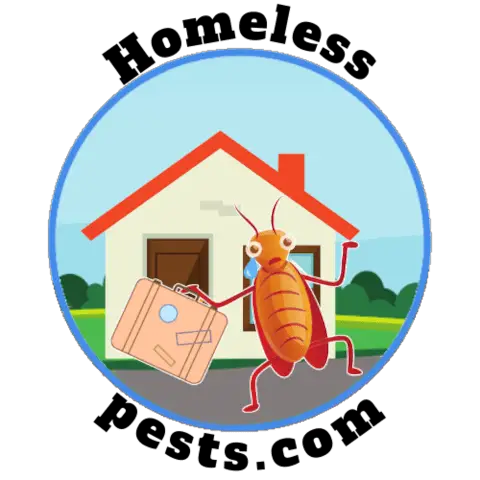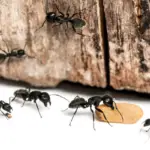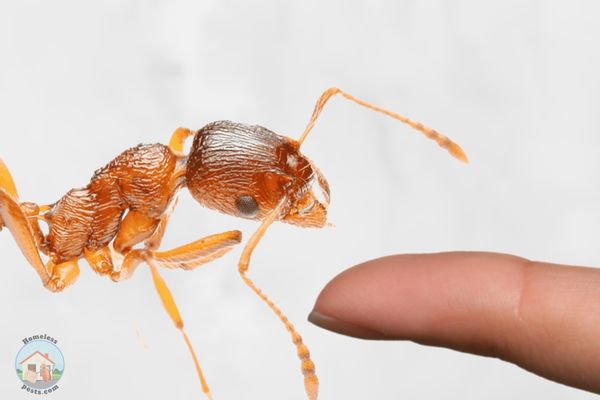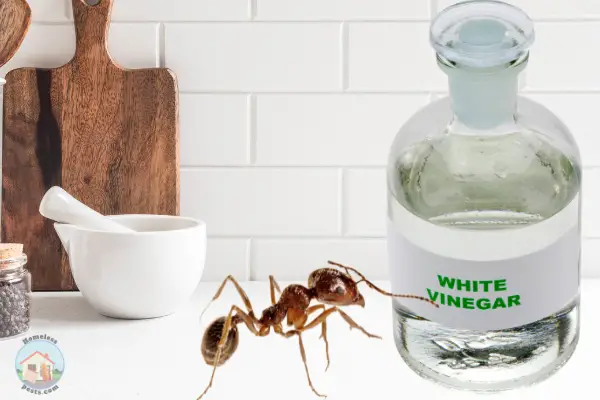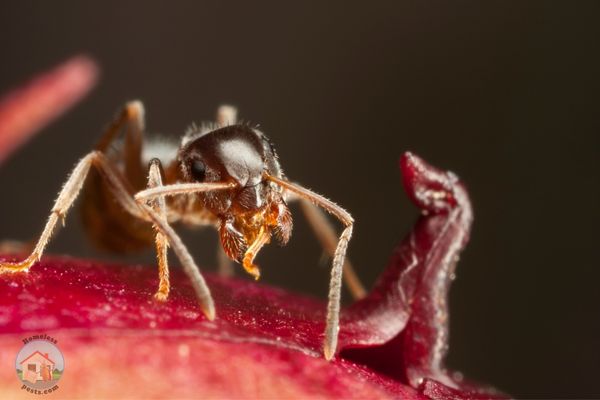Possibly one of the worst periods of the year when it comes to ants is “flying ant day” when you can encounter hundreds or thousands of flying ants.
If you are looking for an effective way to get rid of these winged pests, then you are in the right place. By the end of this article you will know exactly what to do to get rid of these flying ants as well as all the risks they pose to you and your home.
What is a flying ant exactly?
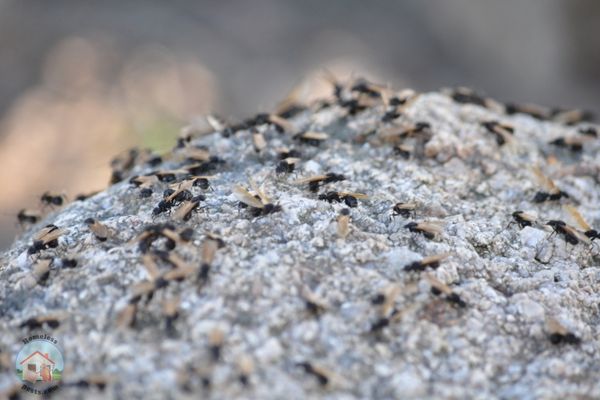
Contrary to what is thought, a flying ant is not a specific species. Most commonly encountered ants have the ability to grow wings and fly. However, they only do this under specific social and atmospheric conditions and their flying days are extremely limited.
Developing wings really only has one purpose in the ant world, sex!
The average ant colony will range from a thousand to a hundred thousand members, and can even grow in excess of that number in super colonies. All of these worker ants are serve just one queen but when the colony needs to expand or be restarted little debutant queens are produced.
When the weather is perfect, normally during the summer months, worker ants and novice queens will leave the nest and swarm together. This “nuptial flight” is really to allow the queens to breed with the male ants and then fly off to start new colonies. Unfortunately for the males, this is their last act as they will soon die after breeding.
Ultimately, flying ants are just a nuisance, but for some species, this time of year poses a real risk to our properties. If you live in an area with swarming Carpenter ants, read my article on how to find and destroy their colonies before they cause expensive damage to your home.
How to identify common US ant species
Below is a quick guide to help you identify the seven most common ants that you will come across around your property.
Fire Ants
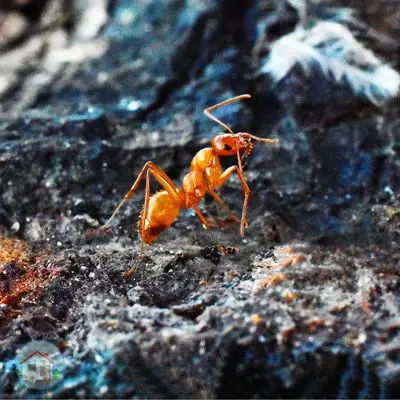
-The red imported fire ant is a common ant found in the Southeastern seaboard and parts of California.
-Fire ants have an exoskeleton and six legs, and their head is typically copper brown in color.
-Worker ants have mandibles, and they use their stinger to inject venom into their prey.
-The result of being stung by a fire ant is a burning sensation and red welts.
-They build a single mound nest in unshaded locations roughly 18 cm tall and 61 cm wide
Odorous House Ants
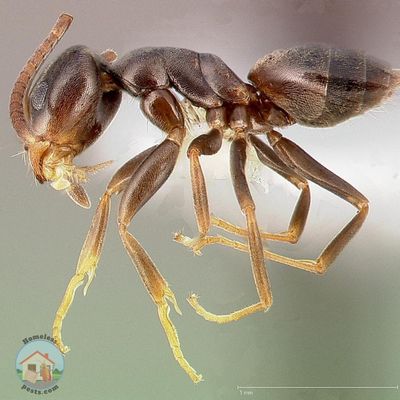
– OHA are small, dark brown to black ants that lack a sting or acidopore and have a slit-like opening on the ventral side of the gaster one segment from the tip.
– Odorous house ants can be found in many places, indoors and outdoors.
– They nest in pre-existing spaces, often near water or food sources.
– OHAs are polygynous, with many queens per colony.
Argentine Ants
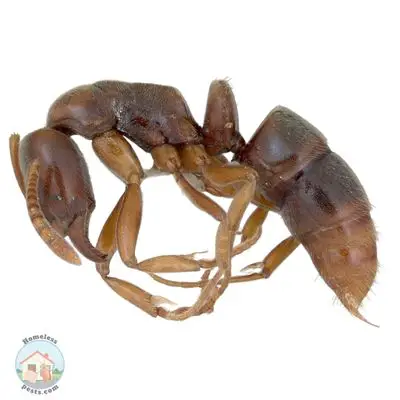
– Argentine ants are typically light to dark brown in color and range between 2.2 to 2.8 mm long.
– They are wingless with a 12-segmented antenna and emit a musty odor when crushed.
– Queens are slightly larger than workers, measuring between 4 to 6 mm long.
– Reproductives queens and males may have wings.
– The most common sign of an Argentine ant infestation is witnessing the trails of ants, often traveling up buildings, trees, and into homes.
Pharaoh Ants

– Pharaoh ants are a small (.2 mm), light yellow to red species of ant that lives in large colonies.
– Pharaoh ants nest in warm, humid areas near food sources like behind baseboards, in walls voids, underneath floors, or behind large appliances.
– Pharaoh ants feed on a wide variety of foods including other insects, sweets, oils, and proteins.
– Pharaoh ants can carry and transmit serious diseases to people including salmonella and Streptococcus.
– Pharaoh ants are difficult to control because they live in large colonies and can “bud” when the colony senses danger meaning the queen will escape.
Thief Ants
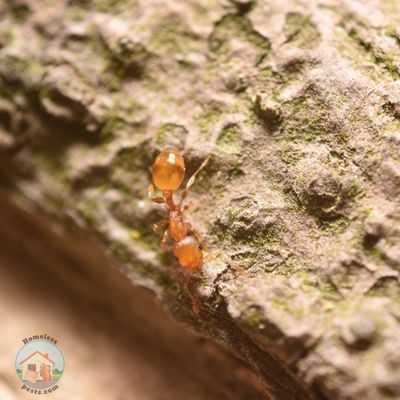
– tiny, yellowish ants that are often confused with Pharaoh ants, but have 2 segments in the club-like structure at the end of the antenna (Pharoah ants has 3 segments)
– lives among other ants and acts as a predator of their brood
– omnivorous and prefer grease or high protein foods over sweets
– often invade houses and may nest indoors in cracks and cupboards
Pavement Ants

– They often construct their nests under the foundation of buildings.
– Small dark brown to black ants (>3mm) that occur in all 50 states.
-There are striations on the head and dorsal surface of their thorax and their 12-segmented antennae end in a 3-segmented club.
-Food can be termites, other insects, sugar or protein based ingredients.
-Pavement ants use a chemical trail to recruit nestmates to a food source.
-Foraging ants are usually active on the floor and along the edge of the walls near door frames at night.
-The workers live for several years and the largest colonies can exceed 10,000 workers.
Carpenter Ants
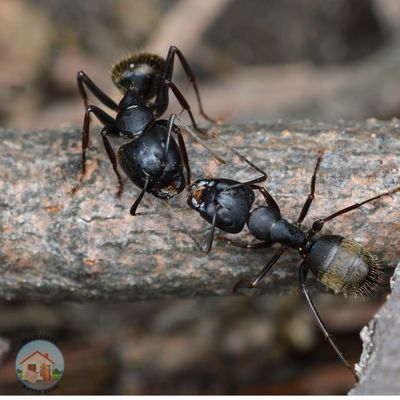
– 24 species of carpenter Ant are recorded in the USA
Carpenter Ants a waist with one node (petiole) and a thorax that is evenly rounded when viewed from the side.
– Workers are usually black or red and black in color.
– Workers usually range in size from 10 – 13 mm in length; one species is just 5mm long.
– Carpenter ant workers of the same species vary in size (major and minor workers).
– Queens and males are larger than workers and have wings. Queens will lose their wings once they start a new nest.
-Queens may be as large as one 2.5 cm.
The effectiveness of regular ant traps on flying ants
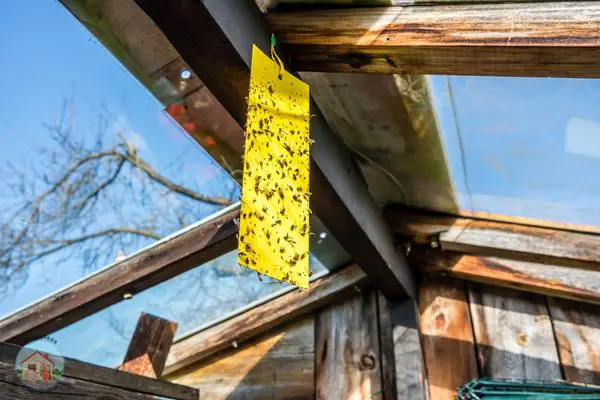
For the most part, flying ants will not harm you or your family. Nonetheless, they are incredibly annoying especially when we want to enjoy a summer evening. Once you’ve picked the twentieth flying ant from your drink, you are ready to get rid of them.
Luckily, common ant traps are effective against flying ants as well as other insects.
Using sticky traps against flying ants
The common sticky trap that you might use against flies is actually quite effective for flying ants. In the numbers that they appear during the swarming mating period, they will soon fill up these types of glue traps.
You only need to set a few of them throughout your house, following the packaging directions, and concentrate on the locations where you’ve seen the most prevalent insect cluster. The flying ants will fly right into them and get stuck, preventing the flying ants from moving forward in any direction.
If you want to make your glue trap and do it yourself, you may place duct tape strips about your house with the adhesive side facing up. This will act as a glue trap. On top of the sticky area, try dusting a little sugar or dripping a little bit of honey to attract the swarm of flying ants.
Using Borax against flying ants
If you are really getting inundated with flying ants, you can try to cut them off at the source and target their colony directly. Borax or its chemical cousin Boric acid is an ideal way to do this.
Borax is a natural element which will destroy an insects digestive system causing death within a few days. When used against traditional forager ants, they will also carry this poison back to their nests and infect their peers.
Although this isn’t going to instantly kill swarming ants, it will slowly reduce their numbers over the course of a few days. It also has the potential to kill off future generations if those novice queens ingest the compound.
For more information on an easy homemade borax ant killer, read my full article here.
Using bug zappers against flying ants
Although most people think that these electric bug zappers are only for mosquitos, they are actually quite effective during a flying ant attack.
Like many insects, ants seem to be attracted to light. To make it even more effective you can also place a sugary solution in or around the bug zapper to make it even more appealing.

If you don’t have one, then you can have one delivered straight to your door by shopping on Amazon today.
Using nets to keep flying ants out
The appearance of swarms of flying ants, although an annual occurrence, is often short-lived and poses very little risk to you. It’s just annoying to have to share our relaxing spaces with these pesky little pests.
By far the easiest way to live in harmony with these ants and not go to the bother of waging war on them is to block them out. A simple mosquito net (in this case ant net) is the best method I’ve found to enjoy a summer evening during “flying ant day”.

I’ve always found that a net that is attached to a tent structure is really easy to set up over an outside seating area. It’s not too inconvenient to get in and out, even when you are entertaining. It’s the same approach that I’ve used to keep mosquitos at bay in my bedroom. If you want to pick up your own outside anti-flying ant net, check out the selection on Amazon now.
Why are flying ants attracted to your home or yard?
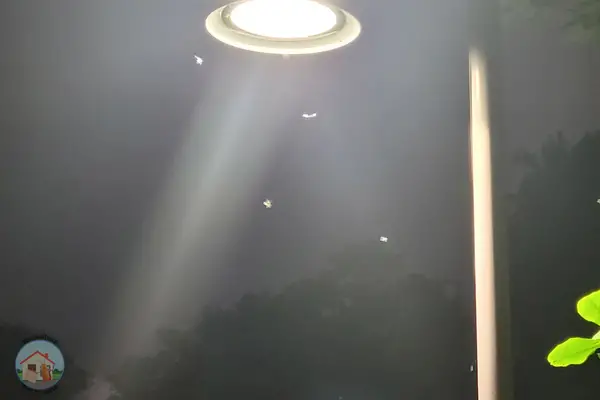
It may feel that you are the only house on the street that is being targeted by flying ants, and this isn’t normally the case. However, there are certain things you may be doing to make your home more attractive than your neighbor’s.
In a nutshell, flying ants usually swarm because of the right combination of heat, light, food, or other weather conditions. Although flying ants occur in all areas of the US, you can see more swarms in rural or suburban areas. This is simply because there are more colonies of ants dotted around these environments.
Heat and Light
Flying ants are drawn to heat and light, so they tend to swarm around at night or on warm evenings. This is why you’ll see them buzzing about your outdoor lighting and lights inside if they can get inside your house.
To minimize their presence, keep yard light off when possible and close any drapes or blinds when the sun goes down. This means they will move next door and trouble Mr. and Mrs. Smith rather than you.
Always keep doors closed and well sealed, and installing effective insect screens on any open windows in your home is a must!
Ants getting in the house
As the warm weather forces most of us to open doors and windows, there is a significant probability that flying ants may find their way into your house. When you add to this the fact that our homes are full of great ant food, the problem becomes even worse.
Most ants like sweet foods, but any crumbs will present a good meal opportunity. This is why it’s always a good idea to store fruit and other sweets in sealed containers or under nets.
Higher Places
Flying ants are also drawn to high areas, which is why you often notice them congregating near chimneys, towers, trees, and the windows of two-story homes. Ensure there are no gaps or fissures in the structure through which they may enter and cause damage to avoid them nesting there.
Effective deterrents and treatments for flying ants
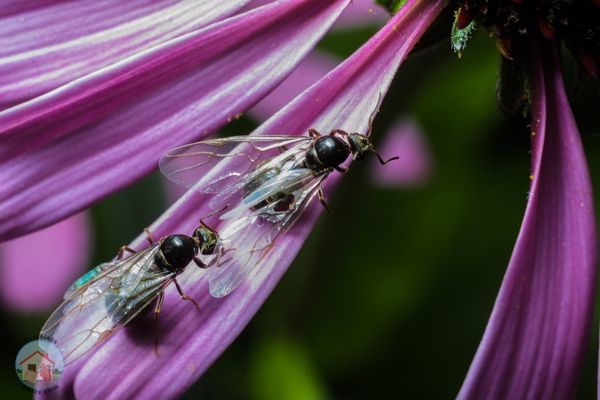
If you have flying ants in your home right now, you will want to get to the bottom of how they gained access. This may not help you in the short term, but it will definitely reduce the number of pests you have in your home in the future.
It is common for flying ants to infiltrate houses via fractures in the walls and cracked wood; thus, you will want to seal these crevices in order to reduce the likelihood that the insects will return.
Get some caulk and a gun designed for caulking, and then use it to fill any gaps that you find in the walls, baseboards, windows, or flooring.
You will be able to see fairly quickly where flying ants are getting in. Also when they are not swarming, ants will leave quite an obvious line or, well other ants, leading in and out of your home.
Spray Your House
Spraying your house with an organic insecticide or repellent every once in a while can remind unwanted guests that they are not welcome. The use of peppermint essential oil is highly recommended.

Place the peppermint oil in a spray bottle, add some water, and shake the container well to combine the ingredients. Spray the surrounding regions where you have previously seen the swarms of flying ants.
Replace Damaged Wood structures
If you see winged ants swarming around moist wooden structures during winter or their foragers inside your home during the winter season, there is a strong likelihood of a nest of ants within your home.
Flying Carpenter ants are second only to termites in terms of their capacity to cause damage to the structure of a building, especially in exposed and damaged woods.
To find out how to deal with this issue and the potential damage they can cause, read my full article on carpenter ants vs termites.
The potential for flying ants to damage your home
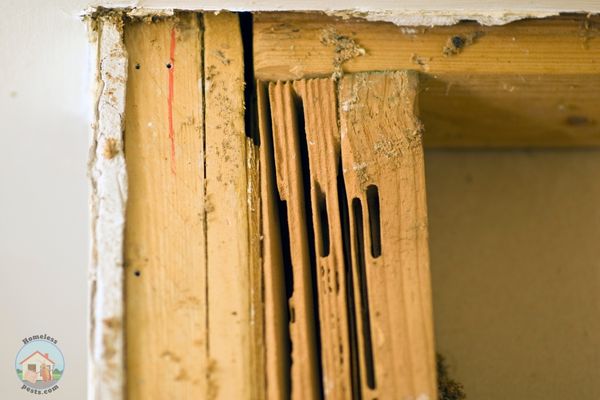
As I’ve mentioned in this article, most types of ants have the ability to swarm in the right situations. However, a few flying ants don’t always mean destruction or that there’s already a colony somewhere in your house. Flying ants might be only passing by and have been attracted to the lights.
So let’s talk about the truth and the real potential threat flying ants pose to you and your property.
Flying ants: Not A Threat To Humans
The threat of flying ants is equivalent to that of their non-winged counterparts. Regardless of whether or not they have wings or stinging insects like carpenter ants, they will only attack when they feel threatened.
Flying ants are mainly concerned with reproduction, so if they do not see you as a danger, they will often leave you alone. This means they are very unlikely to bite you and even if they get in you drink or food, it’s just extra protein for your diet!
Flying ants: Colony Around The Area
If you see flying ants, this is a sign of an established nest in the vicinity, which might be either inside or outside of your house or anywhere around the trees nearby.
When an ant colony has reached maturity and is reaching its maximum number, it will begin to create winged ants and send them out into the environment to establish new nests.
For the most part, ants are great additions to our backyards and have an important role in the ecosystem. However, some ant species are less desirable and the swarming season just means their population is going to increase.
If the ant you observe is a fire ant, for example, you might be in for some problems in the near future. It is best to take necessary measures now to avoid bigger problems in the future.
So, when the swarms come, it’s time to track down their new nests and deal they the death blow as soon as possible.
Final thoughts
Flying ants are for the most part pretty harmless, but when they do become an annoyance there are steps you can take.
Getting yourself a good bug zapper and/or a mosquito net will mean that you can enjoy a nice glass of something in your yard even during a swarm.
These periods of the year are also a wake-up call that new colonies of ants are being created and it might be time to check for potential ant incursions.
Remember, you can always contact your local pest control technician to enlist their help in this fight.

